The TRIAD in human relationships, like the triangle in geometrical
relationships, is the strongest known structure. While later we shall
speak of a 4th dimensional TRIAD, this does not in any way weaken the
previous observation because in present day physics we are coming to
understand that all our structures are bound by, intertwined with and
strengthened by other dimensions.
The reader has been exposed to the concept of cross monitoring in the
TRIAD and it should be observed that geometrically each cross-monitor in
fact creates two additional mirrored triangles - strengthening the
original triangle.
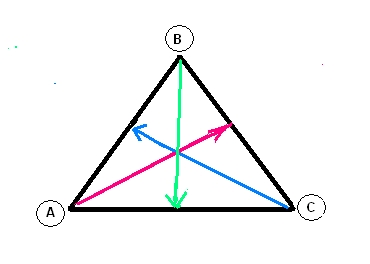 The difficulty with any other form and the weakening of the relationship
can be analyzed by adding just one more side (one more person) to the
social structure. Adding even more - compounds the problem further.
But let us examine a square.
The difficulty with any other form and the weakening of the relationship
can be analyzed by adding just one more side (one more person) to the
social structure. Adding even more - compounds the problem further.
But let us examine a square.
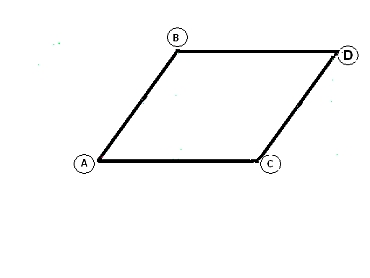 For the square to fully function, each point would require primary
interaction with each of the other primary points. Let us examine this
initially from just position of point A - and at first this appears to
create no particular problem. Perhaps it seems to even be an advantage
because it enriches the interactions and the spectrum of input.
For the square to fully function, each point would require primary
interaction with each of the other primary points. Let us examine this
initially from just position of point A - and at first this appears to
create no particular problem. Perhaps it seems to even be an advantage
because it enriches the interactions and the spectrum of input.
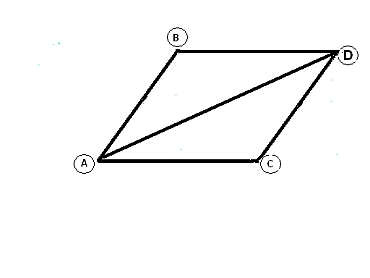 There needs to be these interactions between each of the primary points
and, while this creates a more plentiful number of interactions, we
cannot say that it really creates a problem but rather simply enhances
the richness of the structure. The same observation can be made with
the addition of many additional points, and what we are recognizing here
is the power of the network and why networks are good.
There needs to be these interactions between each of the primary points
and, while this creates a more plentiful number of interactions, we
cannot say that it really creates a problem but rather simply enhances
the richness of the structure. The same observation can be made with
the addition of many additional points, and what we are recognizing here
is the power of the network and why networks are good.
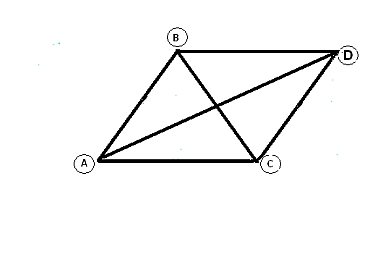 However, once we introduce the principle of objective cross-monitoring
there appears a problem in all structures other than the TRIAD. In
two-point structures, there is of course no cross-monitoring and that is
their deficiency, but in multipoint structures above three the amount
of cross- monitoring increases exponentially. Having just added one
node, the cross monitoring for A has tripled
However, once we introduce the principle of objective cross-monitoring
there appears a problem in all structures other than the TRIAD. In
two-point structures, there is of course no cross-monitoring and that is
their deficiency, but in multipoint structures above three the amount
of cross- monitoring increases exponentially. Having just added one
node, the cross monitoring for A has tripled
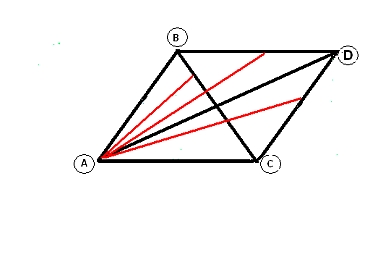 {as it has for all the other two original nodes}.
{as it has for all the other two original nodes}.
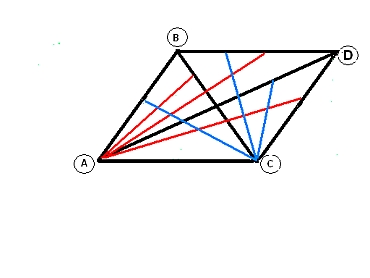
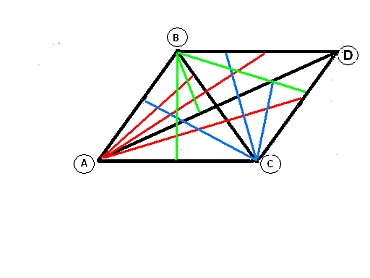 To which we must add the additional new node D:
To which we must add the additional new node D:
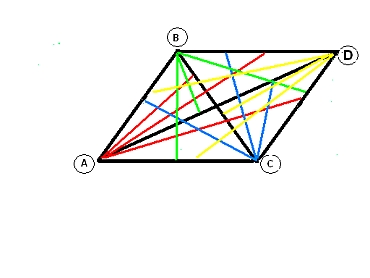 The problem is not just the immensity of the communication that we are
seeing here (which would increase exponentially the more nodes that are
added) but that there becomes conflicting cross- monitoring.
Observe how the line between A and B is being cross-monitored as before
by C, but it is now also being cross-monitored by D. This creates a
conflict. One might argue otherwise and say, no it only creates a
diversity of opinion and that can be good, but this is not so. The
purpose of the cross-monitoring, in the first place, was to enhance and
improve the relationship between A and B. Now, with two cross monitors,
what it does instead is create the potential for conflict and
introduces an instability that can destroy the structure itself. This
will not be obvious to some people, for the same reason that some people
cannot recognize the logical necessity of monotheism and consider that
also to be just a philosophical preference. Nevertheless, the principles
of logic and reason prevail in our life experience and are the
underlying principles of mathematics and science.
The problem is not just the immensity of the communication that we are
seeing here (which would increase exponentially the more nodes that are
added) but that there becomes conflicting cross- monitoring.
Observe how the line between A and B is being cross-monitored as before
by C, but it is now also being cross-monitored by D. This creates a
conflict. One might argue otherwise and say, no it only creates a
diversity of opinion and that can be good, but this is not so. The
purpose of the cross-monitoring, in the first place, was to enhance and
improve the relationship between A and B. Now, with two cross monitors,
what it does instead is create the potential for conflict and
introduces an instability that can destroy the structure itself. This
will not be obvious to some people, for the same reason that some people
cannot recognize the logical necessity of monotheism and consider that
also to be just a philosophical preference. Nevertheless, the principles
of logic and reason prevail in our life experience and are the
underlying principles of mathematics and science.
The diversity of opinion that would arise from multiple cross-monitoring
may be thought to be beneficial in a system such as democracy, but it
is detrimental to the progress and achievement of purpose in a closely
knit system. In a democracy there must be some mechanism, such as
voting and decision by majority for choosing between alternate views,
which we do not have here.
TRIAD decisions are arrived at through consensus, if there is an
intention to arrive at a joint decision. And while culturally there may
be some tendency to abide by the majority opinion, the TRIAD may not be
a decision making group at all. It may be, and often is, just a
consultative informational support group of some sort where each person
does whatever they wish.
Consequently, multiple objective cross-monitoring would be distracting
and lead to conflict -- the exact opposite of the purpose of TRIADs. An
individual in a TRIAD seeking further alternative, diverse or opposite
opinions may freely join additional TRIADs with the other perspectives
or points of view that they are wishing to consider. If their own
perspective changes from interacting with such other sources, they may
then freely bring their new diverse view back to the original TRIAD. In
fact, this sort of practice should be greatly encouraged and that is the
function of TRIAD networking, which thereby it can give linkage to a
great diversity of opinions and viewpoints.
Additional cross-monitoring, however, has nothing to do with the
objective cross-monitoring that takes place in the TRIAD itself. The
purpose of that cross-monitoring is to objectively referee the
interaction between each pair of the three members and to assure the
amicable fairness and quality of their relationship, with the intent of
improving upon its maturity in regards to insight, empathy, and many,
many other virtues.
The means by which this is achieved is an art and skill developed in the
TRIAD process itself. The lines of communication are mathematically
determined to be six by the TRIAD model, certainly enough to track
already without exponentially exploding the paths through the addition
of more nodes.
To describe these lines of communication let us use the model of a
standard email message although much TRIAD communication may be in
person, by telephone or some other means. In an email we have:
Every communication should contain the above. While most email programs
contain a bcc (blind copy) this is something that should not be used in
TRIADs because the whole idea of the mature TRIAD is open and unified
communication.
The 'To:' line can be any one of the three members of the TRIAD being
addressed by any one of the other two members of the TRIAD. There are
therefore 3 possible addresses that can appear on the "To:" line.
The "CC:" line will then have the alternate recipient address for the sender.
If you were to keep a set of files - for each correspondent (member of
the TRIAD including yourself) it would be a hierarchy of the following
order.
TRIADS:
Specific TRIAD: (you can be in several different ones and would need a folder for each individual TRIAD).
Originator A:
Addressee B
Addressee C
Addressee B-C
Originator B:
Addressee A
Addressee C
Addressee A-C
Originator C:
Addressee A
Addressee B
Addressee A-B
Structuring the storage file in this way structures how one thinks about
the TRIAD. Alternatively, all of the messages, from all TRIADs and all
other sources, could of course be dropped in one big storage bin - and
then you could look for messages from a specific originator.
To either just keep together all the TRIAD messages, or the messages from a particular TRIAD, does not accomplish much more.
The structure that I have suggested (although you could use others such
as filing by subject/topic), gives structure and hopefully some support
of what you are doing.
In the suggested structure there is a distinction between messages sent
to the other pair, in the form of a message to the one or the other, and
a copy to the other - versus a monitoring message sent to both.
True, in each case everyone ends up in seeing the same message but the
intent is in the structure, and if you do not see the difference in
structure then you will not be sensitive to intent.
In the TRIAD we have two different things going on.
One is a dialog between two people and the other is an analysis (objective appraisal) of the dialog between two people.
As a matter of TRIAD etiquette it is perhaps best to not address both of
the other members of the TRIAD simultaneously, except in the case of
objective appraisal. This requires a slight amount of effort but perhaps
I can demonstrate this by example.
-----------
From: A
To: B
CC: C
Subject: Meeting place
Message: I will ask C if we can meet at X location tonight. That would that work for you?
From: B
To: A
CC: C
Subject: Meeting place
Message: Y location would be better, if that is alright with you.
From: C
To: B
CC: A
Subject: Meeting place
Message: I note that A is suggesting a meeting at X but you are
suggesting Y. I really don't like Y and would prefer Z. Is that okay?
---------
And around it goes, but no one is addressing both and waiting a group
reply. Everyone is addressed directly although they may preempt, just
as in any real live conversation. The two principles are inclusion and
courtesy.
Now comes the strangest part. If one of the TRIAD (member A in the
following example, but it can be any one of them) decides to critique
the dialog, attitudes, responses, they make an observation directly to
the other pair:
a. About THEIR dialog
b. WITHOUT expecting a response
c. WITHOUT involving their attitude towards A
The purpose is simply to unify the discussion between B and C
From: A
To: B / C
Subject: Location selection
Message: Hey guys, there seems to be some conflict about this meeting
place thing. B always prefers Y and C always prefers Z. Should we
alternate each time or maybe pick a neutral location? Why don't you
each suggest the approach you prefer.
------------
Now this is a very trivial example but it shows the principle of how
civil dialog is maintained, along with mature understanding and
acceptance of each person's purpose.
The matter of directly addressing a single person in a dialog is a good
practice, unless you want everyone to talk at once with a diversity of
ideas.
But the ability to openly interject an alternate solution prevents exclusion and a stilted format.
The overall observation and evaluation of motive, without eliciting a
defensive response, allows for each individual mature analysis of their
role.
The direct messaging and copying, rather than group messaging, is also
more appropriate to some other systems such as Texting, which may be
especially appropriate to TRIAD communication.
This has been a discussion of the technical nature of TRIAD
communication rather than the psychological/spiritual goals and
principles which shall be covered in other chapters. The following
story describes a mentoring TRIAD and, while there is a chapter dealing
with this subject later, the following is an excellent example and this
is as good a place as any for me to place it.
Lunch Date
by Russelle Anne Mcdermott
TRIAD Level Rating 6.0
Dianne (A) and Melissa (B) are co-workers who have recently been
promoted as leaders of their respective teams. They're both excited
about this opportunity for growth but, at the same time, they're
somewhat anxious because they're still young and relatively
inexperienced. Neither of them has held a managerial position before.
One day, while on their break, they decide to approach Jenna (C), a
co-worker who has been a team leader in the company for 2 year, to be
their mentor.
.
--------
A-C "Hi, Jenna. Melissa and I were wondering if we could get
some advice from you on how to be good leaders. We've seen how you are
with your team."
B-C "Yes, we were hoping you'd be interested in forming a TRIAD. We want you to be our mentor."
C-(A/B) "Oh, thank you! I'd be honored to but I do have a lot of
work. So would you two be okay with meeting just once a week for about
an hour? Maybe Friday, lunch time?"
(A/B)-C "Yes, that would be great!"
C-(A/B) "Okay, it's a deal then. Since we're still on break, we
can talk for a few minutes. You can ask me about the basics but save
the tough stuff for later," Jenna winked.
B-C C After a two-second pause, Melissa said, "Well, I feel a
little awkward around my team because I went from being 'one of them' to
being their leader."
A-C "I feel that way, too," Dianne nodded her head.
C-(A/B) "I felt that way in the beginning. You don't have to
stop being their friend, but they also have to realize that you're their
leader now. Be a leader that they respect but aren't afraid to
approach."
B-C "Is that possible?"
C-(A/B) "It definitely is. You'll eventually learn how to
balance your position as a leader and your personal relationship with
your staff.
We use the term ‘leader’ in this company because it is important that
you be more than just a manager. We will have lots to talk about. It
just takes some time. I'll tell you more on our first official
session."
B-C "Okay, let's talk on Friday then."
A-C "We're really looking forward to our meetings as a TRIAD!"
|
|









No comments:
Post a Comment